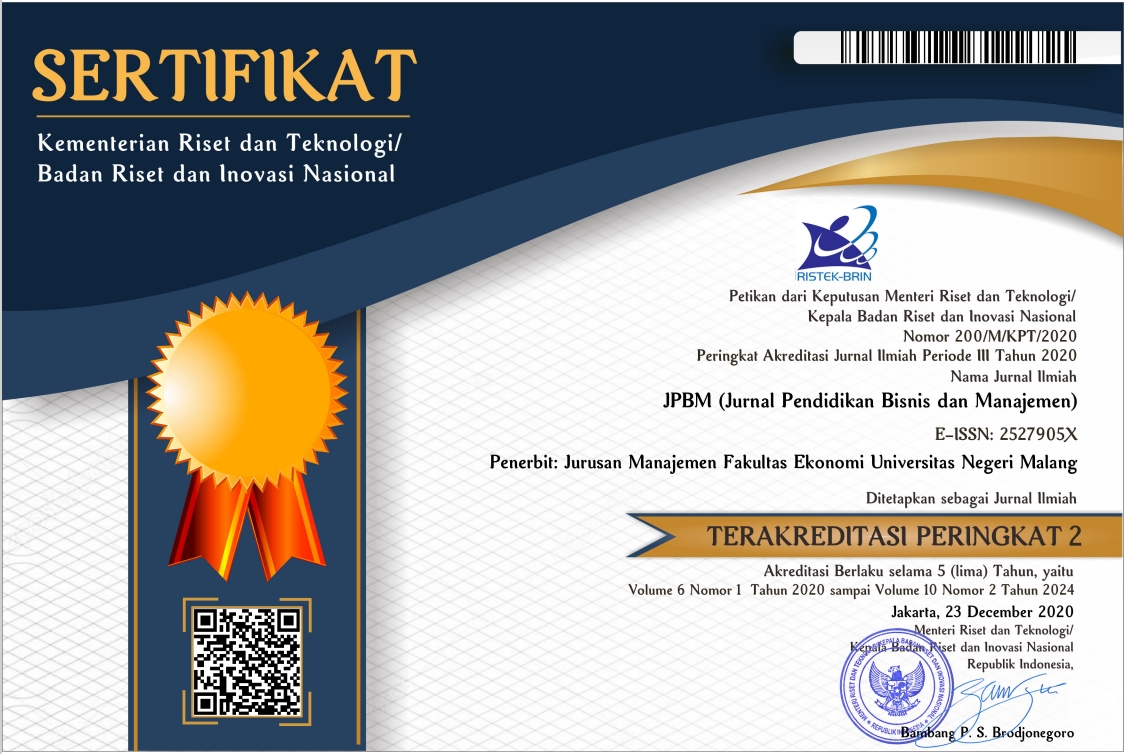The Impact of School Voucher Program on School Dropouts in Indonesia
Abstract
The Indonesian government implemented a school voucher program called Program Indonesia Pintar (PIP) to prevent students from dropping out. PIP is a development of Bantuan Siswa Miskin (BSM). This study empirically analyzes the impact of PIP in reducing the possibility of dropping out at every level of education. The estimation method used in this research is Probit Regression and Marginal Effect. This study compares BSM and PIP's effectiveness and includes PKH (Program Keluarga Harapan) as one of the control variables. The estimation results show that the PIP policy is more effective than BSM in reducing the possibility of dropping out of school at every level of education, both for the full sample and for the subsample of students from families with expenditure levels below the poverty line. PIP has a more significant effect on the subsample of students from poor families than the full sample. Students from poor families who received PIP were 1.9 percent less likely to drop out of school for elementary school. Meanwhile, at the junior high school level, it was 5.1 percent, and at the senior high school level, it was 2.8 percent. In general, there is no impact of PKH in reducing school dropouts.
Keywords: Education, PIP, school dropouts, marginal effect
Full Text:
PDFReferences
Adelman, M., & Szekely, M. (2017). An overview of school dropout in Central America: Unresolved issues and new challenges for education progress. European Journal of Educational Research, Volume 6, 235 - 259. doi:10.12973/eu-jer.6.3.235
Bahri, S. (2020). Dropped out of school prevention through the smart Indonesia Program. Advances in Social Science, Education and Humanities Research, Series Volume Number 532, 470-474. Retrieved from http://creativecommons.org/licenses/by-nc/4.0/
BPS. (2019). Indikator Kesejahteraan Rakyat 2019. Jakarta: Badan Pusat Statistik.
Burde, D., & Linden, L. (2013). Bringing education to Afghan Girls: A randomized controlled trial of village-based schools. American Economic Journal: Applied Economics 2013, 5(3), 27–40. doi:http://dx.doi.org/10.1257/app.5.3.27
Cameron, A., & Trivedi, P. (2005). Microeconometrics methods and applications. Cambridge: Cambridge University Press.
Cameron, L. (2002). Did Social safety net scholarships reduce drop out rate during the Indonesian economic crisis. Policy Research Working Paper 2800.
Camilo, K., & Zuluaga, B. (2022). The effects of conditional cash transfers on schooling and child labor of nonbeneficiary siblings. International Journal of Educational Development.
Cerutti, P., Crivellaro, E., Reyes, G., & Sousa, L. (2018). Income shocks and school dropout in Latin America. Poverty & Equity Global Practice Working Paper 138.
Churchill, S., Iqbal, N., Nawaz, S., & Yew, S. (2021). Unconditional cash transfers, child labour and education: theory and evidence. Journal of Economic Behavior and Organization 186, 437–457. doi:https://doi.org/10.1016/j.jebo.2021.04.012
De Silva, I., & Sumarto, S. (2015). How do educational transfers affect child labour supply and expenditures? Evidence from Indonesia of impact and flypaper effects. Oxford Development Studies.
Duflo, E. (2001). Schooling and labor market consequences of school construction in Indonesia: Evidence from an unusual policy experiment. The American Economic Review, 795-813.
Duflo, E., Dupas, P., & Kremer, M. (2015). School governance, teacher incentives, and pupil–teacher ratios: Experimental evidence from Kenyan primary schools. Journal of Public Economics 123 (2015), 92-110. doi:http://dx.doi.org/10.1016/j.jpubeco.2014.11.008
Glewwe, P., & Kassouf, L. (2012). The impact of the Bolsa Escola/Familia conditional cash transfer program on enrollment, dropout rates and grade promotion in Brazil. Journal of Development Economics, 505–517. doi:10.1016/j.jdeveco.2011.05.008
Glewwe, P., Hanushek, E., Humpage, S., & Ravina, R. (2011). School resources and educational outcomes in developing countries: A review of the literature from 1990 to 2010. NBER Working Paper Series. Retrieved from http://www.nber.org/papers/w17554
Glewwe, P., Lambert, S., & Chen, Q. (2020). Education production functions: updated Education production functions: updated. In The Economics of Education, Second Edition (pp. 183-215). Elsevier Ltd. doi:https://doi.org/10.1016/B978-0-12-815391-8.00015-X
Handa, S. (2002). Raising primary school enrolment in developing countries The relative importance of supply and demand. Journal of Development Economics 69 (2002), 103–128.
Hanushek, E. (2020). Education production functions. In the economics of education, Second Edition (pp. 161-170). Stanford, CA, United States: Elsevier Ltd. doi:https://doi.org/10.1016/B978-0-12-815391-8.00013-6
Hidayatina, A., & Ozanne, A. (2019). Can cash transfers mitigate child labour? Evidence from Indonesia’s cash transfer programme for poor students in Java. World Development Perspectives.
Janvry, A., Finan, F., & Sadoulet, E. (2012). Local electoral inentives and decentralized program performance. The Review of Economics and Statistics, 672–685.
Khiem, P., Linh, D., Tai, D., & Dung, N. (2020). Does tuition fee policy reform encourage poor children’s school enrolment? Evidence from Vietnam. Economic Analysis and Policy.
Lee, K., & Hwang, M. (2016). Conditional cash transfer against child labor: Indonesia Program Keluarga Harapan. Asia Pacific Educ. Rev., Education Research Institute, Seoul National University.
Mandic, S., Sandretto, S., & Bengoechea, E. (2017). Enrolling in the closest school or not? Implications of school choice decisions for active transport to school. Journal of Transport & Health.
Mukherjee, A. N. (2007). Public expenditure on education : A review of selected issues and evidence. National Institute of Public Finance and Policy, New Delhi.
Nikmah, F. A., Wardani, N. T., & Matsani, N. (2020). Apakah kartu indonesia pintar berhasil menurunkan angka putus sekolah? Jurnal Komunikasi Pendidikan, Vol.4 No.2, 11-17.
Pastore, F. (2012). “I Wish I Had 100 Dollars a month …” The Intergenerational transfer of poverty in Mongolia. IZA Discussion Paper No. 6487.
Setiyono, B., & Pradoto, W. (2019). Managing school voucher program in developing country: Lesson from Smart Indonesia Program. World Conference on Social Sciences. Budapest, Hungary.
Setyadharma, A. (2018). Government’s cash transfers and school dropout in rural areas. JEJAK: Journal of Economics and Policy Vol 11 (2), 450 – 464. doi:https://doi.org/10.15294/jejak.v11i2.16125
Sumarto, S., & Silva, I. (2015). How do educational transfers affect child labour supply and expenditures? Evidence from Indonesia of impact and flypaper effects. Oxford Development Studies.
Suprastowo, P. (2014). Kontribusi bantuan siswa miskin terhadap keberlangsungan dan keberlanjutan pendidikan siswa. Jurnal Pendidikan dan Kebudayaan, 20, (2), 149-172.
Suryadarma, D., Suryahadi, A., & Sumarto, S. (2006). Causes of Low Secondary School Enrollment in Indonesia. SMERU Research Institute.
Unesco Institute for Statistic, & Unicef. (2016). Monitoring education participation. Unicef Series on Education Participation and Dropout Prevention - Volume 1.
Unicef. (2020). The state of children in Indonesia- Trends, Opportunities and Challenges for Realizing Children’s Rights.
Yulianti, N. (2015). The functioning and effect of a cash transfer program in Indonesia. International Institute if Social Studies.
Refbacks
- There are currently no refbacks.
JPBM (Jurnal Pendidikan dan Bisnis Manajemen) is licensed under a Creative Commons Attribution-NonCommercial-ShareAlike 4.0 International License.
JPBM (Jurnal Pendidikan dan Bisnis Manajemen) is abstracted and indexed in :
















